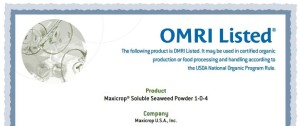Liquid Seaweed Fertilizer
Liquid seaweed is great nourishment for plants but is different from most N P K fertilizer treatments. In fact seaweed only contains a little K – potassium. But it has many other minerals, vitamins, and enzymes that are natural growth stimulants. Many of these are not found elsewhere. These nutrients fuel the plant cells’ growth, and this results in healthier, stronger, and more disease-resistant plants. Expect an increased uptake of nutrients from the soil, better resistance to frost and other stress conditions, increased resistance to pests, and best of all, increased yields!
University studies report that applications of seaweed improved yields in potatoes, tomatoes, peppers, strawberries and corn, and geraniums produced more flowers per plant; grapes were sweeter; gladiolus corms grew larger; and cucumber yields increased 40 percent and the fruits suffered less often from softening and rotting.
Seaweed extends the shelf life of fruits and vegetables if applied 10 days before harvesting. It lengthens the life of cut flowers if they are sprayed with liquid seaweed a day or two before cutting.
Liquid seaweed shouldn’t be used as your only fertilizer. Nitrogen (N), phosphorus (P), and potassium (K) should come from another source.
For several years, I have done seaweed fertilization with the powdered version of a product called Maxicrop. It is also sold in a liquid form, but mixing the soluble powdered form is much more cost effective. A 10.7 ounce container will make 65 gallons! It dissolves very easily in water and my plants enjoy the excellent source of nutrition that seaweed provides.
The downside to mixing it yourself is that it’s messy. When the powder gets wet, it can create stains that take some effort to clean. Also, don’t mix it up outside when it’s windy. The powder will blow away. If you buy Maxicrop in a pouch, it’s useful to move it into a jar with a screw top lid so you have more control and there’s less chance that it will spill.
For awhile I sold Maxicrop in our natural garden store. It sold very well. I had happy customers who would return for more on a regular basis. I just looked at the reviews and Amazon customers are happy with it too; over 100 reviewers average 4.6 stars (out of 5).
Maxicrop uses seaweed that is harvested along the Norwegian coastline, an excellent seaweed growing environment. There are thousands of varieties of seaweeds, and very few have value for plant life. This seaweed from Norway has been thoroughly tested and its value proven. Maxicrop is a non-polluting, renewable resource, and is OMRI listed, meaning that it is approved for use in gardens and farms that are certified organic.

Seaweed fertilizers can be used as a soil treatment. And since most plants absorb their nutrients through the leaves, applying it with a foliar method will benefit the plant even more. As the plant absorbs sunlight, it will also absorb the nutrients in the fertilizer.
Alginates (sponge-like starches found in seaweed), hold water droplets near the plant roots, making moisture available to them without drowning them. They also help enrich the soil by feeding a myriad of beneficial microorganisms.
Soaking seeds with liquid seaweed prior to planting will improve seed germination, root growth, and early seedling vigor. Liquid seaweed also can be used as a rooting solution. Place cuttings in a solution of liquid seaweed and water until roots develop, then plant. It reduces transplant shock and speeds root growth.

